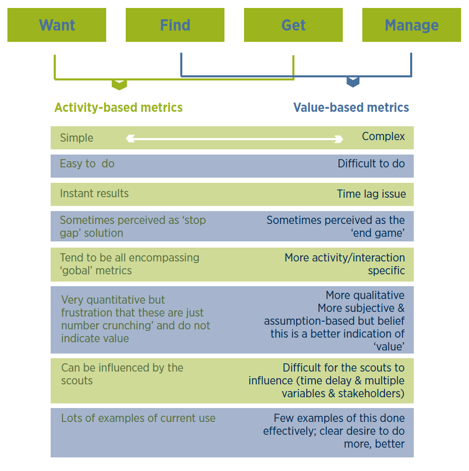“What gets measured, gets managed.” Peter Drucker. With the ever-growing focus on business metrics, it is no surprise that Open Innovation practitioners are increasingly seeking ways to measure OI.
We’ve been having a really interesting discussion in the OI Forum about this topic, which seems to fit in the ‘high importance – high difficulty’ quadrant!
I thought it would be worth sharing some of our thinking and also reaching out for inputs from the R&D Today community.
Measuring outputs not just activity
The challenge with measuring the value of investment in Open Innovation is highlighted in the graphic below which recognises that while it is relatively easy to measure activity associated with the early Want and Find stages of OI it is much more difficult to capture the outputs/value generated.

The interest in ‘outputs’ rather than ‘activity’ boils down answering the million-dollar question:
‘How do we measure the value of investments in Open Innovation activity so that we can make decisions about future portfolio balance between open innovation programmes and investing in in-house research’.
Clearly there are several parts to this:
- Measuring value derived from Open Innovation – the key challenges are the time lags involved and the sample-size available, and these are equally true of any innovation investment – open or internal. We want to make decisions now, but data won’t be available until long after launch; perhaps many years before the full returns can be appreciated. Also, with any one organisation only having a limited portfolio of investments, results are skewed (favourably or unfavourably) by a single ‘hero project’ or equally by a major failure.
- When is innovation ‘open’ – the question arises of when should a program be classified as ‘open’. Innovation efforts are rarely 100% in-house or external; rather a blend of these two complementary resources.
- How do we determine causality – what activity leads to what value/outputs, and what is the threshold where we decide whether there was a significant ‘open’ aspect? The cynical answer might be that it depends on the ultimate success of the investment and who is trying to support which agenda!
Insights into metrics from General Mills
Published data from companies’ OI programs is hard to come by, but here are a couple of great data points on both activity and output metrics from an interview with Mike Helser, senior manager of the General Mills Worldwide Innovation Network, known as ‘G-WIN’.
Q. Metrics. A lot of our readers struggle with measuring success, or even identifying the innovation metrics to track. How do you think about measuring the success of G-WIN?
A. One key metric we track is the percentage of our new product launches that encompass a significant amount of open innovation. Prior to launching G-WIN in 2007, less than 10 percent of our new product launches were externally enabled. Today (in 2014), around 35 percent of our innovation projects at General Mills are externally enabled. Additionally, we have expanded our innovation capacity by nearly 40 percent through additional headcount from external sources collaborating on our projects.
Another benefit we’ve realized is that our new product launches with a significant external component had 2.2 times higher Year-One sales than those developed internally.
It would be really interesting to hear from the RnDToday community how you measure Innovation – especially relating to outputs and to open innovation. Please feel free to share your metrics (with or without the actual data).
Post by Dominic Oughton

